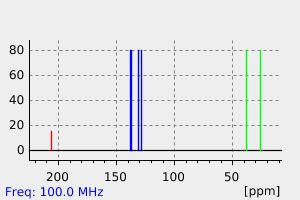(2Z,4Z)-2,4-环辛四烯并二烯-1-酮 | 10095-80-4
中文名称
(2Z,4Z)-2,4-环辛四烯并二烯-1-酮
中文别名
——
英文名称
cycloocta-2,4-dien-1-one
英文别名
2,4-Cyclooctadien-1-on;2,4-cyclooctadienone;2,4-cycloctadienone;Δ2,4-Cyclooctadienon;Cyclooctadien-2,4-on;2,4-Cyclooctadienon;(2Z,4Z)-cycloocta-2,4-dien-1-one
CAS
10095-80-4
化学式
C8H10O
mdl
——
分子量
122.167
InChiKey
QRPIEZZXVJNFTA-FIGGJLSXSA-N
BEILSTEIN
——
EINECS
——
-
物化性质
-
计算性质
-
ADMET
-
安全信息
-
SDS
-
制备方法与用途
-
上下游信息
-
文献信息
-
表征谱图
-
同类化合物
-
相关功能分类
-
相关结构分类
物化性质
-
沸点:24-27 °C(Press: 0.1 Torr)
-
密度:0.977±0.06 g/cm3(Predicted)
计算性质
-
辛醇/水分配系数(LogP):1.4
-
重原子数:9
-
可旋转键数:0
-
环数:1.0
-
sp3杂化的碳原子比例:0.38
-
拓扑面积:17.1
-
氢给体数:0
-
氢受体数:1
安全信息
-
海关编码:2914299000
SDS
反应信息
-
作为反应物:描述:(2Z,4Z)-2,4-环辛四烯并二烯-1-酮 在 palladium on activated charcoal 氢气 作用下, 以 乙醇 、 苯 为溶剂, 生成 6ar,6bt,12ac,12bc-tetradecahydrocycloocta[3,4]cyclobuta[1,2][8]annulene-1,12-dione参考文献:名称:2,4-环辛二烯酮的光化学 I. 在苯和甲苯中摘要:显示在苯或甲苯中的 2,4-环辛二烯酮 (1) 的辐照以 >80% 的产率产生两个头对头的二聚体。显示环融合发生在二烯酮的 α,β-位置,具有反式-顺式和反式-反式立体化学。两种二聚体可以通过顺-反-顺环融合差向异构化为相同的产物。有证据表明单线态负责 1 到高反应性中间体反式、顺式-2,4-环辛二烯酮的顺反异构化。该中间体可以在热 2 + 2 环加成中二聚化,或者可以在 -78° 下生成,然后在 Diels-Alder 反应中被 1,3-二烯捕获。讨论了二聚反应的机理。DOI:10.1139/v73-332
-
作为产物:描述:参考文献:名称:Cycloalkin-vinylidencycloalkan-umlagerungen摘要:DOI:10.1016/s0040-4039(01)93493-8
文献信息
-
Synthetic Photochemistry. XLVI. Cycloaddition of<i>exo</i>,<i>endo</i>-2,7-Bis(methoxycarbonyl)-11,12-dioxatetracyclo[6.2.1.1<sup>3,6</sup>.0<sup>2,7</sup>]dodeca-4,9-diene and Conjugated Enones and<i>p</i>-Quinones作者:Guan Rong Tian、Akira Mori、Nobuo Kato、Hitoshi TakeshitaDOI:10.1246/bcsj.62.506日期:1989.2Photocycloaddition of exo,endo-2,7-bis(methoxycarbonyl)-11,12-dioxatetracyclo[6.2.1.13,6.02,7]dodeca-4,9-diene with conjugated enones and p-quinones occurred exclusively at the exo-addition moiety to give [2+2]cycloadducts. From cyclohexenone, all four possible photoadducts were obtained. A single photoadduct from cyclopentenone was a cis-transoid-cis isomer. Upon thermolysis, cyclobutene derivatives were formed from these photoadducts. An acid treatment of oxetane derivatives derived from photoadducts of p-quinones afforded Michael adducts instead of dienone–phenol rearrangement products.
-
Photochemical reactions, 135th communication Photochemistry of Homoconjugated Cyclobutanones. II. Decisive Effect ofgem- Dimethyl Substitution on the Course of the Oxa-di-?-methane Rearrangement作者:Terry A. Lyle、Hari Babu Mereyala、Alfons Pascual、Bruno FreiDOI:10.1002/hlca.19840670319日期:1984.5.2The synthesis and photolysis of the spirocyclobutanones 4–7 incorporating a cyclohexa-, cyclohepta- and cyclooctadiene moiety, respectively, is described. On triplet excitation, these compounds undergo isomerization via a 1,2-acyl shift involving one or both double bonds of the diene system. The presence of a gem-dimethyl group as in 1, 4 and 7 dramatically changes the photoproduct distribution, since
-
Synthesis of Cycloocta-3,5-dien-1-ol and Cycloocta-3,5-dien-1-one: SeO2/O2 Oxidation of Dienes作者:Elena S. Koltun、Steven R. KassDOI:10.1055/s-2000-7107日期:——A useful synthesis of cycloocta-3,5-dien-1-ol was developed starting from cycloocta-1,3-diene. Oxidation of the diene with selenium oxide in refluxing acetic anhydride affords the homoallylic and allylic acetates in a 19 : 1 ratio and a 36% overall yield when O2 is bubbled through the reaction mixture. Subsequent reduction with LAH affords the homoallylic alcohol (95%), which can be readily oxidized via TPAP/N-MMO (73%) to the corresponding non-conjugated dienone. This route represents the most efficient method for the preparation of cycloocta-3,5-dien-1-ol and cycloocta-3,5-dien-1-one reported to date, and may provide a general approach to the synthesis of homoallylic alcohols and non-conjugated enones.
-
Photochemistry of 2,4-Cyclooctadienone. II In Neutral and Acidic Methanol作者:Gordon L. Lange、Eli NeidertDOI:10.1139/v73-333日期:1973.7.1Irradiation of 2,4-cyclooctadienone (1) in neutral dry methanol resulted in the formation of 3-methoxy-4-cyclooctenone (18%) and two head-to-head 2 + 2 dimers (combined yield 64%). A similar irradiation in acidic methanol (0.001 N HCl) caused a dramatic change in the products formed. A new compound, the dimethyl ketal of trans, cis-2,4-cyclooctadienone was formed in 67% yield along with the two dimers
-
[EN] PHOSPHORUS COMPOUNDS AND METHODS THEREOF<br/>[FR] COMPOSÉS PHOSPHORÉS ET LEURS PROCÉDÉS申请人:AGENCY SCIENCE TECH & RES公开号:WO2022132048A1公开(公告)日:2022-06-23The disclosure concerns phosphorus compounds of formula (I), (II) and (III) and methods of synthesising these compounds. The phosphorus compound can be a cyclic phosphorus compound. The method comprises reacting a compound having two Michael acceptor groups with a hypophosphite ester, acid, salt or solvate thereof and an optional organosilicon compound. The diene can be a cyclodiene.
表征谱图
-
氢谱1HNMR
-
质谱MS
-
碳谱13CNMR
-
红外IR
-
拉曼Raman
-
峰位数据
-
峰位匹配
-
表征信息
同类化合物
(反式)-4-壬烯醛
(s)-2,3-二羟基丙酸甲酯
([1-(甲氧基甲基)-1H-1,2,4-三唑-5-基](苯基)甲酮)
(Z)-4-辛烯醛
(S)-氨基甲酸酯β-D-O-葡糖醛酸
(S)-3-(((2,2-二氟-1-羟基-7-(甲基磺酰基)-2,3-二氢-1H-茚满-4-基)氧基)-5-氟苄腈
(R)-氨基甲酸酯β-D-O-葡糖醛酸
(5,5-二甲基-2-(哌啶-2-基)环己烷-1,3-二酮)
(2,5-二氟苯基)-4-哌啶基-甲酮
龙胆苦苷
龙胆二糖甲乙酮氰醇(P)
龙胆二糖丙酮氰醇(P)
龙胆三糖
龙涎酮
齐罗硅酮
齐留通beta-D-葡糖苷酸
鼠李糖
黑芥子苷单钾盐
黑海棉酸钠盐
黑木金合欢素
黑曲霉三糖
黑介子苷
黄尿酸8-O-葡糖苷
麻西那霉素II
麦迪霉素
麦芽糖脎
麦芽糖基海藻糖
麦芽糖1-磷酸酯
麦芽糖
麦芽四糖醇
麦芽四糖
麦芽十糖
麦芽六糖
麦芽五糖水合物
麦芽五糖
麦芽五糖
麦芽五糖
麦芽三糖醇
麦芽三糖
麦芽三糖
麦芽三塘水合
麦芽七糖水合物
麦芽七糖
麦法朵
麦可酚酸-酰基-Β-D-葡糖苷酸
麦利查咪
麝香酮
鹤草酚
鸢尾酚酮 3-C-beta-D-吡喃葡萄糖苷
鸡矢藤苷







